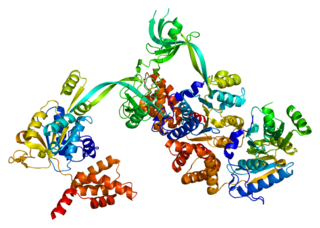RUVBL1
gen de la especie Homo sapiens
RuvB-like 1 (E. coli), también conocido como RUVBL1 y TIP49, es una proteína codificada en humanos por el gen ruvBL1, y perteneciente a la familia de proteínas AAA+.[1] RUVBL1 puede formar un hexámero, el cual, a su vez, puede formar un dodecámero con la proteína RUVBL2.[2]
| RuvB-like 1 (E. coli) | ||||
|---|---|---|---|---|
 Estructura tridimensional de la proteína RUVBL1. | ||||
| Estructuras disponibles | ||||
| PDB |
Lista de códigos PDB 2c9o
| |||
| Identificadores | ||||
| Símbolos | RUVBL1 (HGNC: 10474) ECP54, NMP238, RVB1, TIP49, TIP49A | |||
| Identificadores externos | ||||
| Locus | Cr. 3 q21.3 | |||
| Ortólogos | ||||
| Especies |
| |||
| Entrez |
| |||
| UniProt |
| |||
| RefSeq (ARNm) |
| |||
Interacciones editar
La proteína RUVBL1 ha demostrado ser capaz de interaccionar con:
Referencias editar
- ↑ «Entrez Gene: RUVBL1 RuvB-like 1 (E. coli)».
- ↑ «Dodecameric structure and ATPase activity of the human TIP48/TIP49 complex».
- ↑ Ewing, Rob M; Chu Peter, Elisma Fred, Li Hongyan, Taylor Paul, Climie Shane, McBroom-Cerajewski Linda, Robinson Mark D, O'Connor Liam, Li Michael, Taylor Rod, Dharsee Moyez, Ho Yuen, Heilbut Adrian, Moore Lynda, Zhang Shudong, Ornatsky Olga, Bukhman Yury V, Ethier Martin, Sheng Yinglun, Vasilescu Julian, Abu-Farha Mohamed, Lambert Jean-Philippe, Duewel Henry S, Stewart Ian I, Kuehl Bonnie, Hogue Kelly, Colwill Karen, Gladwish Katharine, Muskat Brenda, Kinach Robert, Adams Sally-Lin, Moran Michael F, Morin Gregg B, Topaloglou Thodoros, Figeys Daniel (2007). «Large-scale mapping of human protein-protein interactions by mass spectrometry». Mol. Syst. Biol. (England) 3: 89. PMID 17353931. doi:10.1038/msb4100134.
- ↑ Bauer, A; Huber O; Kemler R (Dec. de 1998). «Pontin52, an interaction partner of beta-catenin, binds to the TATA box binding protein». Proc. Natl. Acad. Sci. U.S.A. (UNITED STATES) 95 (25): 14787-92. ISSN 0027-8424. PMID 9843967.
- ↑ a b Park, Jeonghyeon; Wood Marcelo A, Cole Michael D (Mar. de 2002). «BAF53 forms distinct nuclear complexes and functions as a critical c-Myc-interacting nuclear cofactor for oncogenic transformation». Mol. Cell. Biol. (United States) 22 (5): 1307-16. ISSN 0270-7306. PMID 11839798.
- ↑ a b Fuchs, M; Gerber J, Drapkin R, Sif S, Ikura T, Ogryzko V, Lane W S, Nakatani Y, Livingston D M (Aug. de 2001). «The p400 complex is an essential E1A transformation target». Cell (United States) 106 (3): 297-307. ISSN 0092-8674. PMID 11509179.